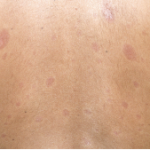What Can We Learn From Other Fibrosing Disorders?
Given the rarity of Ssc (for example, rheumatoid arthritis is about 20-fold more common), it may be of interest to see whether other fibrotic disorders can provide some clues into the pathogenesis of this disease. In the spring of 1981, an explosive outbreak of pneumonitis occurred in Spain, focused at first in the vicinity of Madrid and then extending to provincial areas, especially to the northwest. Patients typically presented with cough, dyspnea, pleuritic chest pain, headache, fever, and bilateral pulmonary infiltrates on imaging studies.6 Some patients developed skin thickening and joint contractures, Raynaud’s phenomenon, and debilitating neuropathies. Initially, the epidemic was attributed to infectious causes, but shortly after the outbreak, a strong association with food oils sold as olive oil but containing a high proportion of rapeseed oil began to be recognized. These suspect oils were identifiable as being inexpensive, sold in unlabeled five-liter plastic containers, and usually acquired from itinerant salesmen. Epidemiologic studies confirmed that all patients had ingested this tainted oil. Though the precise cause of the epidemic is not known, it most likely involved the adulteration of a particular batch or batches of rapeseed oil. Denatured with 2% aniline and intended for industrial use, rapeseed oil was regularly imported into Spain. Its low cost had encouraged chemical denaturation via the removal of aniline, with subsequent clandestine distribution for food use, primarily among poorer populations. Fortunately, the toxic oil syndrome has never been seen again.
At the end of the decade, in October 1989, the New Mexico Department of Health and Environment was notified of three patients with severe myalgia and peripheral eosinophilia. All three had been taking oral preparations of the amino acid L-tryptophan.7 Even though the patients had undergone extensive clinical evaluation and testing, their illnesses were not consistent with any known diagnostic entity. Public announcement of the cluster quickly led to reports of similar cases. Within one month, more than 30 additional cases were identified in New Mexico and about half of these patients had been hospitalized. Aside from a marked eosinophilia, most of them developed incapacitating myalgias, hence the term eosinophilia–myalgia syndrome (EMS) was coined.
Investigators analyzed a variety of predisposing factors, such as the use of different vitamins, other health foods or raw food products, medications, and water sources. They concluded that all of the affected patients were found to have recently ingested L-tryptophan–containing products. Subsequent studies confirmed that a change in the manufacturing protocol at one chemical plant in Japan accounted for most of the contaminated L-tryptophan supplements associated with the development of EMS. It was a dreadful illness. Aside from the incapacitating myalgias, which were only partially responsive to treatment with corticosteroids, some patients went on to develop a disabling, widespread fasciitis and an often fatal form of pulmonary fibrosis.

